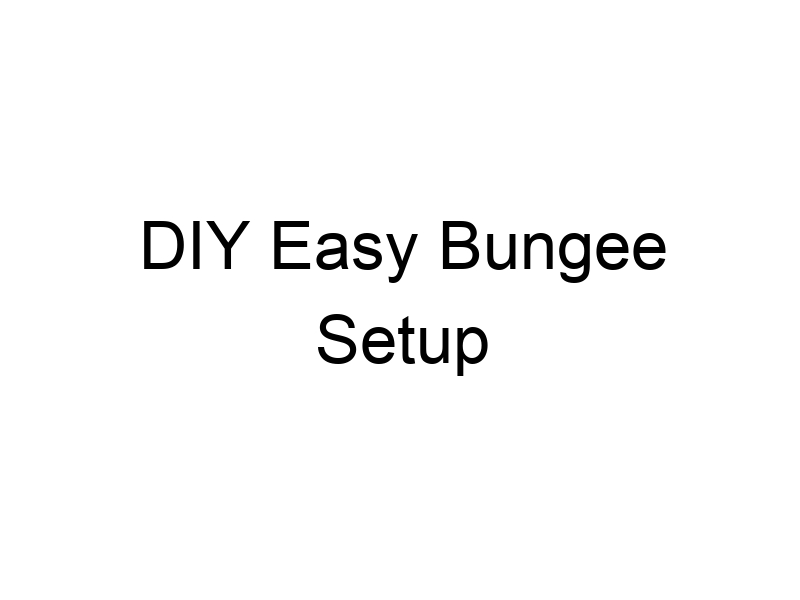Ever thought about setting up your own DIY bungee? It’s 2025, and creating your own bungee system is not only a fun project but also a great way to save some cash. Whether you’re looking to add some thrill to your backyard or want a unique exercise setup, building a bungee can be a rewarding experience. Just remember, safety first! Let’s dive into the basics and get you started on your bungee adventure.
Key Takeaways
- DIY bungee setups are a cost-effective way to enjoy bungee activities.
- Understanding the right materials is crucial for a safe setup.
- Safety should always be your top priority when setting up and using a bungee.
- Testing your setup thoroughly ensures it functions correctly and safely.
- Innovative uses for bungees include exercise and recreational activities.
Understanding the Basics of DIY Bungee Setup
What is a DIY Bungee?
A DIY bungee system is a homemade setup that mimics the commercial bungee cords used for various purposes, including sports and recreational activities. Building your own bungee setup can be both cost-effective and rewarding, allowing you to customize it to your specific needs. Essentially, it involves using elastic cords, anchors, and connectors to create a flexible and strong system that can absorb shock and provide bounce.
Benefits of Creating Your Own Bungee
Creating your own bungee setup has several advantages:
- Cost Savings: Commercial bungee systems can be pricey. Making your own can save you money.
- Customization: You can tailor the length, strength, and components to suit your needs.
- Learning Experience: Building a bungee system enhances your understanding of physics and mechanics.
Safety Considerations
Safety should be your top priority when creating a DIY bungee setup. Here are some key points to consider:
- Inspect Materials: Ensure all components, especially the bungee cord, are in good condition and strong enough for your intended use.
- Secure Anchors: Make sure anchors are properly installed and can handle the tension.
- Regular Checks: Frequently inspect your setup for wear and tear to prevent accidents.
Creating a DIY bungee setup is an exciting project, but it requires careful attention to detail to ensure safety and functionality. Always prioritize safety, and don’t hesitate to consult experts if you’re unsure about any aspect of your build.
Essential Materials for Building a Bungee System

Choosing the Right Bungee Cord
Picking the perfect bungee cord is the backbone of your setup. Bungee cords typically have a core made from rubber or synthetic rubber-like materials, which determine their capacity to endure stretching. When selecting a bungee cord, consider the following:
- Length and thickness: These determine the stretch and strength. A longer, thicker cord provides more elasticity.
- Material: Opt for cords with a durable rubber core for better longevity.
- Weather resistance: Ensure the cord can withstand the elements if used outdoors.
Selecting Anchors and Connectors
Anchors and connectors are crucial for securing your bungee system in place. Here’s what to keep in mind:
- Weight capacity: Choose anchors that can support the expected load. For instance, a 16-pound anchor might suffice for lighter setups, but heavier systems may require a 25-pound anchor.
- Material: Stainless steel or galvanized metal connectors resist rust and wear.
- Versatility: Look for connectors that allow easy attachment and detachment.
Tools You Will Need
Having the right tools makes assembly smoother and safer. Here’s a list of essentials:
- Measuring tape: To ensure accurate lengths for your bungee cord and setup.
- Utility knife: For cutting the bungee cord to the desired length.
- Wrenches and pliers: Necessary for tightening connectors and anchors.
- Safety gear: Gloves and goggles to protect yourself during assembly.
Building your own bungee system is both exciting and rewarding, but it requires careful selection of materials and tools. By ensuring you have the right components, you set the foundation for a safe and functional setup. Remember, preparation is key to success in any DIY project.
Step-by-Step Guide to Assembling Your Bungee
Alright, let’s kick things off with the bungee cord. First, you need to get your hands on a high-quality bungee cord. The length and thickness will depend on what you’re planning to use it for, but generally, a 20-foot length of 3/8-inch thick cord is a solid choice. Start by measuring and cutting the cord to your desired length. Make sure your cuts are clean and the ends are sealed to prevent fraying. You can use heat or a simple adhesive tape wrap for this.
Attaching the Connectors
Now, onto the connectors. These are crucial as they link your bungee to whatever you’re attaching it to. You’ll want climbing-grade carabiners or heavy-duty hooks. Here’s a quick rundown:
- Open the connector and thread it through the loop at the end of your bungee.
- Secure it by tying a strong knot like a bowline or figure-eight.
- Double-check that the connector is locked tight and there’s no chance of it slipping.
Securing the Anchor Points
Finally, let’s talk anchors. This is the part that keeps everything in place. You can use anything from a sturdy tree to a specially designed ground anchor. Here’s how to set it up:
- Choose a solid anchor point that’s not going anywhere.
- Attach the other end of your bungee to the anchor using a secure knot or loop.
- Test the tension by pulling on the bungee to ensure it doesn’t budge.
Once everything is set, give it a few test pulls to make sure it holds up. Safety first, always.
For those looking for more in-depth guidance on setting up anchors, check out resources that cover detailed steps and tips. Remember, a good anchor is key to a successful bungee setup.
Safety Measures and Precautions
Inspecting Your Setup
Before even thinking about taking that first jump, give your bungee setup a thorough check. Look over every inch of your bungee cords, harnesses, and anchors. If anything looks worn or frayed, it’s time to replace it. Regular checks ensure everything is up to snuff and can prevent accidents. Keep an eye on weather conditions too; rain or wind can mess with your setup.
Using Safety Gear
When it comes to safety gear, don’t skimp. A good helmet and sturdy gloves are a must. Consider wearing knee and elbow pads, especially if you’re new to bungee jumping. Proper equipment can make all the difference. Make sure everything fits snugly but comfortably. And remember, it’s not just about having the gear; it’s about using it right.
Emergency Procedures
Accidents happen, even with the best precautions. Have a plan for when things go sideways. Know where the nearest phone is to call for help, and have a basic first aid kit on hand. It’s smart to have someone with you who knows CPR and basic first aid. Being prepared can save lives. Practice these procedures so everyone involved knows what to do in case of an emergency.
Safety isn’t just a checklist; it’s a mindset. Approach your bungee setup with caution and respect, and always prioritize safety over thrill. This approach not only protects you but also ensures a more enjoyable experience.
Testing Your DIY Bungee Setup
Initial Test Runs
Before you dive headfirst into using your DIY bungee setup, it’s important to start with some initial tests. Safety should always come first. Begin by assessing the tension and flexibility of your bungee cord. Attach it securely to the anchors and give it a few test pulls. This will help you understand how it behaves under stress. Make sure to check for any unexpected slack or excessive tension that could indicate a problem.
Adjusting Tension and Length
Once you’re satisfied with the initial tests, it’s time to fine-tune the tension and length of your bungee cord. Here’s a simple step-by-step guide:
- Measure the desired length: Decide how much stretch you need for your bungee activities.
- Adjust the anchors: Ensure that the Glass Filled Nylon Hooks are securely fastened and adjust them as needed to achieve the right tension.
- Test and repeat: Pull the cord to test the tension. If it’s too loose or too tight, make necessary adjustments and retest until you’re satisfied.
Troubleshooting Common Issues
Even with the best setup, things can go wrong. Here are a few common issues and how to address them:
- Cord Slippage: If the bungee cord slips from the anchors, check the connectors and ensure they are properly secured.
- Uneven Stretch: This might happen if the cord is not evenly distributed. Adjust the cord placement and retest.
- Anchor Movement: If your anchor shifts during use, consider using heavier or more stable anchors.
Testing your DIY bungee setup is all about patience and precision. Take your time to ensure everything is just right before you start using it for real. Remember, a well-tested setup not only performs better but also keeps you safe.
Innovative Uses for Your DIY Bungee
Bungee for Exercise
Setting up a bungee system for exercise can be a fantastic way to get a full-body workout. Imagine transforming your backyard into a personal gym with a bungee setup. This system can be used for resistance training, which helps in building strength and improving flexibility. You can attach the bungee to a sturdy frame or between two strong posts, allowing for various exercises such as squats, lunges, and even some aerial moves. Incorporating bungee exercises into your routine can make workouts more engaging and fun.
Bungee for Water Sports
Using a bungee for water sports is another innovative application. Whether it’s wakeboarding, water skiing, or even foil surfing, a bungee can provide the necessary pull to get you started. By setting up a bungee system on a dock or a boat, you can create a self-launch mechanism that eliminates the need for a motorized boat. This DIY approach not only saves money but also offers a unique way to enjoy water sports.
Creative Recreational Uses
The versatility of a DIY bungee setup extends beyond exercise and water sports. You can use it for creative recreational activities like setting up a slingshot for launching objects or even creating a fun zip line for kids. Bungee cords can also be used in obstacle courses, adding an element of challenge and excitement. With a bit of creativity, the possibilities are endless, making your bungee setup a centerpiece for fun and innovation in your outdoor space.
A DIY bungee system is not just a tool; it’s a gateway to endless possibilities, encouraging creativity and active lifestyles.
For more ideas on how to utilize bungee cords in various practical applications, check out our innovative uses for bungee cords.
Maintaining Your Bungee System

Regular Inspection Tips
Keeping your bungee system in top shape is all about regular check-ups. Inspect the cords for any signs of wear and tear, such as fraying or thinning. It’s a good idea to run your fingers along the length of the bungee to feel for any weak spots. Also, check the connectors and anchors for rust or damage. If anything looks off, it might be time to replace that part.
Repairing Wear and Tear
When you spot damage, don’t wait too long to fix it. Small tears can quickly become big problems. You can patch minor frays with strong adhesive tape, but for anything more serious, consider replacing the bungee cord. Make sure the connectors are tight and secure; loose connectors can cause accidents. If you’re using a Bungee Buddy, it can help keep your cords organized and in good condition.
Storing Your Bungee Safely
Proper storage is key to extending the life of your bungee system. Keep the cords in a cool, dry place away from direct sunlight, as UV rays can weaken the material. Consider coiling the cords neatly and using a storage tool, like the Bungee Buddy, to prevent tangling. This not only keeps your bungees tidy but also makes them last longer.
Taking the time to maintain your bungee setup ensures it stays safe and functional. A little effort now can save you a lot of hassle later on.
Cost-Effective Tips for Building a Bungee

Sourcing Affordable Materials
Building your own bungee setup doesn’t have to break the bank. Start by sourcing materials from local hardware stores or online marketplaces. Look for sales or discounts on bungee cords and other essentials. You might even find second-hand items that are in good condition. Don’t shy away from asking around in community groups or forums for any spare equipment someone might be willing to part with.
DIY vs. Store-Bought Options
When it comes to bungee setups, you have two main routes: DIY or store-bought. While store-bought options can be convenient, they often come with a hefty price tag. On the other hand, DIY setups allow for customization and can be significantly cheaper if you already have some basic tools. Building your own bungee setup can be a rewarding experience and gives you the flexibility to tailor it to your specific needs.
Budgeting for Your Project
Budgeting is crucial to avoid overspending. Start by listing all necessary materials and tools, and then research their costs. Create a spreadsheet to track expenses and compare prices from different suppliers. Set a maximum budget and stick to it, allowing a small buffer for unexpected costs. Remember, a well-planned budget can help you achieve a functional bungee setup without financial strain.
Crafting your own bungee system is not just about saving money; it’s about creating something unique and tailored to your needs. With a bit of creativity and resourcefulness, you can enjoy the thrill of bungee activities without the high price tag.
Advanced Techniques for Bungee Enthusiasts
Customizing Your Bungee Setup
If you’re ready to take your bungee setup to the next level, customization is key. Tailoring your bungee system to suit your personal needs can enhance both safety and enjoyment. Consider adjusting the length and tension of the cords to match your weight and activity type. This might mean experimenting with different types of bungee cords or adding extra safety features like adjustable harnesses. A little tweak here and there can make a big difference.
Incorporating Technology
In today’s world, technology can play a big role in refining your bungee experience. Think about integrating sensors to monitor tension and force, providing real-time feedback. This data can help you make informed adjustments to your setup, ensuring optimal performance. Some enthusiasts even use apps to track their bungee sessions, offering insights into improvement areas.
Exploring New Bungee Challenges
Once you’ve nailed the basics, why not explore new challenges? Testing your setup in different environments can keep things exciting. Whether it’s bungee fitness or trying out water-based bungee activities, pushing the boundaries can lead to thrilling experiences. Remember, safety first—always inspect your equipment before trying something new.
“Venturing into advanced bungee techniques opens up a world of possibilities, turning a simple setup into a versatile adventure tool.”
Community Insights and Shared Experiences
Learning from Other DIYers
Getting into the world of DIY bungee setups can be quite the adventure. Connecting with fellow enthusiasts is a great way to learn and grow. Many folks share their experiences on forums, detailing what worked and what didn’t. You’ll find stories of triumphs and mishaps, offering valuable lessons without having to make the same mistakes yourself.
Sharing Your Bungee Journey
Don’t keep your bungee projects to yourself! Sharing your journey can be rewarding and inspiring for others. Consider posting about your setup process, challenges, and creative solutions. This not only helps others but also opens the door for feedback and new ideas.
Joining Bungee Enthusiast Groups
There are numerous groups where bungee fans come together to discuss and share ideas. Whether it’s a local club or an online forum, these communities are treasure troves of knowledge and support. Engaging in these groups can provide insights into seeing players beyond your current server, making your bungee experience even richer.
Being part of a community allows you to expand your horizons, learn new techniques, and maybe even find lifelong friends who share your passion for bungee adventures.
Legal and Ethical Considerations

Understanding Local Regulations
Before diving into your DIY bungee project, it’s essential to get familiar with the local rules. Check out local laws regarding bungee setups, especially if you’re planning to use public spaces. Some areas might have specific permits or restrictions. It’s not just about avoiding fines; it’s about ensuring everyone’s safety.
Respecting Public Spaces
If you’re setting up your bungee system in a park or another public area, remember you’re sharing this space. Be considerate of others who might be using the area. Clean up after yourself, and make sure your setup doesn’t damage the environment or disrupt other activities.
Ensuring Ethical Use
Think about the ethical side of things. Is your bungee setup safe for everyone who might use it? Are you considering the impact on the community? An ethical DIY project means everyone can enjoy it without harm. Keep communication open with those around you to address any concerns they might have.
Taking the time to understand and follow legal and ethical guidelines not only protects you but also enhances the community experience. It’s about creating a fun and safe environment for everyone involved.
Wrapping It Up: Your DIY Bungee Adventure
So, there you have it! Crafting your own bungee setup is not just a fun project but also a rewarding experience. Sure, it might take a bit of time and patience, but the thrill of using something you built with your own hands is unbeatable. Plus, you get to save some bucks along the way. Just remember, safety first! Double-check everything before you take that leap. And hey, if it doesn’t work out perfectly the first time, don’t sweat it. Tweak it, test it, and try again. Who knows, you might just become the go-to bungee expert in your circle. Happy bouncing!
Frequently Asked Questions
What is a DIY bungee setup?
A DIY bungee setup is a homemade version of a bungee system that you can create using materials like bungee cords, anchors, and connectors. It’s a cost-effective way to enjoy bungee activities without buying a commercial setup.
Why should I make my own bungee system?
Making your own bungee system can save you money and allow you to customize it to your needs. Plus, it’s a fun project that lets you learn and experiment with building your own gear.
Is it safe to create a DIY bungee setup?
Safety is very important when making a DIY bungee setup. Always use strong materials, follow instructions carefully, and regularly check your setup for wear and tear to ensure it remains safe to use.
What materials do I need for a DIY bungee system?
You’ll need bungee cords, anchors, connectors, and some basic tools like a drill and wrench. Choosing the right materials is crucial for a safe and effective setup.
Can I use a DIY bungee for exercise?
Yes, a DIY bungee can be used for exercise, like resistance training or bungee workouts. Just make sure it’s securely anchored and tested for safety before use.
How do I test my DIY bungee setup?
Start with small, controlled tests to check the tension and strength of your setup. Gradually increase the load and make adjustments as needed to ensure everything is working properly.
What should I do if my bungee setup breaks?
If your bungee setup breaks, stop using it immediately. Inspect all parts to identify what went wrong, replace any damaged components, and make necessary repairs before using it again.
Are there any legal considerations for using a DIY bungee?
Yes, check local regulations to ensure your bungee activities are allowed in your area. Always use your setup responsibly and respect public spaces and safety guidelines.







